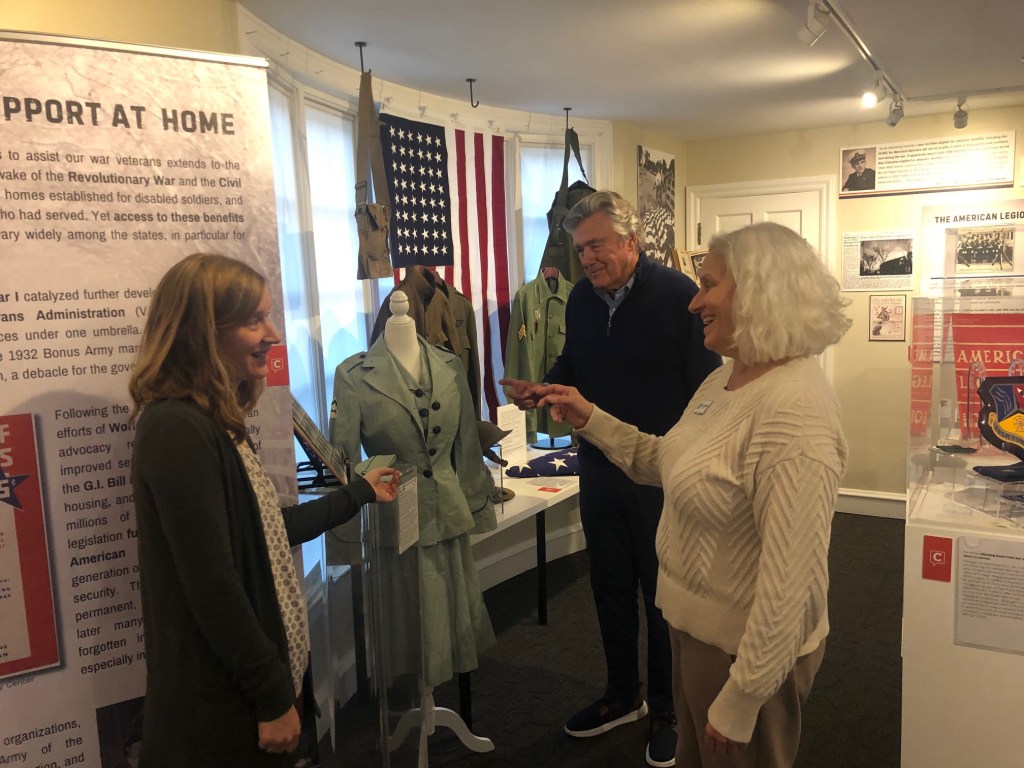Throughout the nation’s history, United States veterans have received stated expressions of gratitude for their military service. However, the corresponding actions have at times been different.
Such is the focus of a new exhibit in Lake Forest.
On Nov. 8, the History Center of Lake Forest-Lake Bluff opened Returning Home from War providing an examination on different types of assistance veterans have received when they came back home from military service.

“The goal was how do we do a comprehensive narrative that looks at what that transition has been like over 100 years,” History Center Executive Director Carol Summerfield said.
History Center officials mention the exhibit’s local resonance given Lake Forest’s proximity to Naval Station Great Lakes just to the north and the former bases of Fort Sheridan and the Naval Air Station in Glenview.
“Because of that Lake Forest had a front row seat to the care and the treatment of veterans in America,” Summerfield said.
The exhibit showcases photographs, memorials and uniforms providing a snapshot on how local residents have fought in every U.S. conflict since the Civil War.
Moreover, a series of information panels providing the exhibit’s three-part theme. The signs detail the evolution of medical care the veterans received, financial and educational support and the reception veterans they got once they returned to the community.
Regarding medical care, Summerfield said Fort Sheridan had a medical hospital open between 1918 and 1920 until the conclusion of World War I.
Overall, the American government shut down almost 3000 hospitals six months after the conflict once known as The Great War.
Later on, the North Chicago VA Medical Center opened in 1926, which is now part of the James A. Lovell Federal Health Care Center.
“It is the very first partnership between veteran’s affairs, the Department of Defense and it serves both active duty soldiers and veterans,” Summerfield explained.
Care has evolved and Summerfield said she was surprised the American government did not supply prosthetic limbs after World War II, but they started a research and development area for prosthetic limbs.
“To this day the American government is one of the largest innovators of artificial limbs on Earth,” Summerfield noted.
Local veteran John Ormsby acknowledges the medical situation hasn’t always been great for veterans, but believes there have been improvements.
“Many people have paid a heavy price and I’m very sensitive to that. But to my knowledge the medical care is much better than it has been in the past,” Ormsby said.
In terms of financial assistance, History Center officials tell the story of the Bonus Army during which veterans were set to receive a $625 certificate in 1924, but were not eligible for full payment until 1945.
The frustration boiled over in 1932, with the country seeing the worst of the Great Depression, two veterans were killed in a violent confrontation in Washington D.C.
Summerfield said U.S. Franklin Roosevelt was more sensitive to the financial needs of veterans which led to the 1944 GI Bill, which provided assistance to those who served in World War II.
“A lot of the suburban growth expands out of that as people were getting money for housing up here and were able to start families and they were able to get readily affordable housing quickly,” exhibit curator Laurie Stein noted.
Looking at the success of the GI Bill from a local angle, Stein said Lake Forest College’s enrollment doubled after World War II with veterans taking advantage of the GI Bill.
The third component of the exhibit is a look at the general treatment of veterans.
“While we have this notion that World War I and II vets were treated with great deference and really given honors when they came back,” Summerfield said. “Not always. They were treated well but not necessarily recognized for their contribution.”
In Lake Forest, the reception was more nuanced as there were individual moments of salute such as a 1919 dinner at the Durand Art Institute at Lake Forest College, pictured at the exhibit. However, in 1948, residents voted down a proposed $250,000 war memorial project.
A generation later in 1973, Vietnam veterans were welcomed home in a parade, which was not necessarily the case in other parts of the nation as some people turned their anger over the controversial war toward those who served.
“The treatment ebbed and flowed,” Stein said. “I was not expecting to find that.”
Since the opening tied into Veteran’s Day, many people who were active in the military have been stopping by offering support, Summerfield stated.
“They really like this exhibit,” she said. “They feel it honors the truth of their experiences. It helps them think they made a difference.”
She hopes additional veterans stop by, but they will start detailing their experiences.
“We want these stories to live another 100 years so it is important that we collect them,” she said.
The exhibit is scheduled to run through next March.
Daniel I. Dorfman is a freelance reporter for Pioneer Press.

